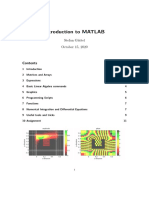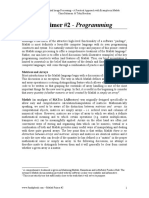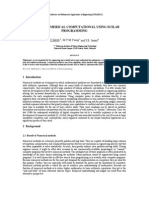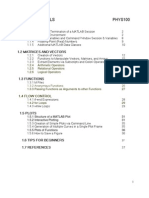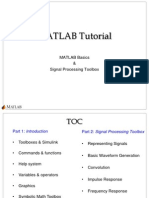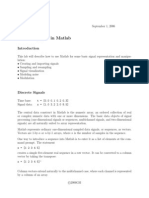Introduction to MATLAB
SAJID GUL KHAWAJA
�Introduction
2
What is MATLAB ?
MATLAB is a computer program that combines computation and visualization power that makes it particularly useful tool for engineers.
MATLAB is an executive program, and a script can be made with a list of MATLAB commands like other programming language.
MATLAB Stands for MATrix LABoratory.
The system was designed to make matrix computation particularly easy.
The MATLAB environment allows the user to:
manage variables import and export data perform calculations generate plots develop and manage files for use with MATLAB.
�MATrix LABoratory
3
www.mathworks.com Advantages of MATLAB Ease of use Platform independence Predefined functions Plotting
Disadvantages of MATLAB Can be slow Commercial software
�MATLAB Screen
4
Command Window type commands Current Directory View folders and mfiles Workspace View program variables Double click on a variable to see it in the Array Editor Command History view past commands save a whole session using diary
�Variables
5
No need for types. i.e.,
int a; double b; float c;
All variables are created with double precision unless
specified and they are matrices.
Example: >>x=5; >>x1=2;
After these statements, the variables are 1x1 matrices with
double precision
�Variables Types
6
Variable types Numeric Logical Character and string Cell and Structure Function handle
�Variables (cont)
7
Variable names:
Must start with a letter
Youll get an error if this doesnt happen
May contain only letters, digits, and the underscore _ MATLAB is case sensitive, i.e. one & OnE are different variables. MATLAB only recognizes the first 31 characters in a variable name. Variable = number; Variable = expression;
>> tutorial = 1234; >> tutorial = 1234 tutorial = 1234
Assignment statement:
Example:
NOTE: when a semi-colon ; is placed at the end of each command, the result is not displayed.
�Variables (cont)
8
Dont name your variables the same as functions
min, max, sqrt, cos, sin, tan, mean, median, etc Funny things happen when you do this i, j, eps, nargin, end, pi, date, etc i, j are reserved as complex numbers initially
MATLAB reserved words dont work either
Will work as counters in my experience so they can be redefined as real numbers
Give meaningful (descriptive and easy-to-remember)
names for the variables. Never define a variable with the same name as a MATLAB function or command.
�Special Variables
9
Special Values
MATLAB includes a number of predefined special values. These values can be used at any time without initializing them. These predefined values are stored in ordinary variables. They can be overwritten or modified by a user. If a new value is assigned to one of these variables, then that new value will replace the default one in all later calculations. >> circ1 = 2 * pi * 10; >> pi = 3; >> circ2 = 2 * pi * 10;
Never change the values of predefined variables.
�Special Variables (cont)
10
Special variables:
ans : default variable name for the result pi: = 3.1415926 eps: = 2.2204e-016, smallest amount by which 2 numbers can differ. Inf or inf : , infinity NaN or nan: not-a-number
who: lists the names of defined variables whos: lists the names and sizes of defined variables clear: clears all varialbes, reset the default values of special variables. clear name: clears the variable name clc: clears the command window clf: clears the current figure and the graph window.
Commands involving variables:
�Interactive Commands
11
Format of output Defaults to 4 decimal places Can change using format statement format long changes output to 15 decimal places
�Operators (arithmetic)
+ addition - subtraction * multiplication / division ^ power complex conjugate transpose
12
�Operators
13
Scalar arithmetic operations
Operation
MATLAB form
ab ab a / b = a/b a \ b = b/a a+b b a^b a*b a/b a\b a+b a-b
Exponentiation: ^ Multiplication: * Right Division: / Left Division: \ Addition: + Subtraction: - a
MATLAB ignores white space between variables
and operators
�Operators (relational, logical)
14
== Equal to
~= Not equal to
< Strictly smaller > Strictly greater
<= Smaller than or equal to
>= Greater than equal to & And operator
| Or operator
�Operators (Element by Element)
15
.* ./ .^
element-by-element multiplication element-by-element division element-by-element power
�Order of Operations
16
Parentheses
Exponentiation
Multiplication and division have equal precedence Addition and subtraction have equal precedence
Evaluation occurs from left to right
When in doubt, use parentheses MATLAB will help match parentheses for you
�Vectors, Matrices and Arrays
17
Vectors Array Operations Matrices
�Vectors, Matrices and Arrays
18
Arrays
The fundamental unit of data in MATLAB
Scalars are also treated as arrays by MATLAB (1
row and 1 column).
Row and column indices of an array start from 1. Arrays can be classified as vectors and
matrices.
�Vectors, Matrices and Arrays
19
Vector: Array with one dimension Matrix: Array with more than one dimension Size of an array is specified by the number of rows
and the number of columns, with the number of rows mentioned first (For example: n x m array).
Total number of elements in an array is the product of the number of rows and the number of columns.
�Arrays
20
Variables and Arrays Array: A collection of data values organized into rows
and columns, and known by a single name.
Row 1 Row 2 Row 3 arr(3,2) Row 4 Col 1 Col 2 Col 3 Col 4 Col 5
�21
1 2 a= 3 4 5 6 b=[1 2 3 4] 1 c= 3 5 a(2,1)=3
Row # Column #
3x2 matrix 6 elements 1x4 array 4 elements, row vector 3x1 array 3 elements, column vector
b(3)=3
c(2)=3
�Vectors
22
A row vector in MATLAB can be created by an explicit list, starting with a left
bracket, entering the values separated by spaces (or commas) and closing the vector with a right bracket. A column vector can be created the same way, and the rows are separated by semicolons. Example: >> x = [ 0 0.25*pi 0.5*pi 0.75*pi pi ] OR x = [ 0 0.25*pi, 0.5*pi, 0.75*pi , pi] x= 0 0.7854 1.5708 2.3562 3.1416 x is a row vector. >> y = [ 0; 0.25*pi; 0.5*pi; 0.75*pi; pi ] y= 0 0.7854 y is a column vector. 1.5708 2.3562 3.1416
�Vectors (cont)
23
Vector Addressing A vector element is addressed in MATLAB with an
integer index enclosed in parentheses. Example:
>> x(3) ans = 1.5708
3rd element of vector x
The colon notation may be used to address a block of elements. (start : increment : end)
start is the starting index, increment is the amount to add to each successive index, and end is the ending index. A shortened format (start : end) may be used if increment is 1.
Example:
>> x(1:3) ans = 0 0.7854 1.5708
1st to 3rd elements of vector x
NOTE: MATLAB index starts at 1.
�Vectors
24
Some useful commands:
x = start:end
create row vector x starting with start, counting by one, ending at end create row vector x starting with start, counting by increment, ending at or before end
x= start:increment:end
length(x)
y = x dot (x, y)
returns the length of vector x
transpose of vector x returns the scalar dot product of the vector x and y.
�Arrays and Matrices
25
Initializing with Shortcut Expressions
first: increment: last
Colon operator: a shortcut notation used to initialize arrays with thousands of elements
>> x = 1 : 2 : 10; >> angles = (0.01 : 0.01 : 1) * pi;
Transpose operator: () swaps the rows and columns of an array 1 1 2 2 >> g = [1:4]; h= 3 3 >> h = [ g g ]; 4 4
�Long Array, Matrix
26
t =
t =1:10
k =
1 2 3 k =2:-0.5:-1 2 1.5 1
10
0.5
-0.5
-1
x =
B
1 5
= [1:4; 5:8] 2 6 3 7 4 8
�Matrices Addressing
27
Matrix Addressing:
-- matrixname(row, column) -- colon may be used in place of a row or column reference to select the entire row or column.
Example:
>> f(2,3)
ans = 6 >> h(:,1) ans = 2 1
recall: f= 1 4 h= 2 1
2 5 4 3
3 6 6 5
�Generating Vectors/Matrices from functions
28
zeros(M,N)
MxN matrix of
zeros
x = zeros(1,3) x = 0 0 0 x = ones(1,3) x = 1 1 1 x = rand(1,3) x = 0.9501 0.2311 0.6068
ones(M,N)
MxN matrix of ones
rand(M,N)
MxN matrix of uniformly distributed random numbers on (0,1)
�Array Operations
31
Scalar-Array Mathematics For addition, subtraction, multiplication, and division of an array by a scalar simply apply the operations to all elements of the array. Example: >> f = [ 1 2; 3 4] f= 1 2 3 4 >> g = 2*f 1 Each element in the array f is g= multiplied by 2, then subtracted 1 3 by 1. 5 7
�Array Operations (cont)
32
Element-by-Element Array-Array Mathematics.
Operation Addition Subtraction Multiplication Division Exponentiation
Algebraic Form a+b ab axb ab ab
MATLAB a+b ab a .* b a ./ b a .^ b
Example:
>> x = [ 1 2 3 ]; >> y = [ 4 5 6 ]; >> z = x .* y z = 4 10 18
Each element in x is multiplied by the corresponding element in y.
�Matrices Some Useful Commands
33
Length(A) Size(A)
returns the larger of the number of rows or columns in A. for a m x n matrix A, returns the row vector [m,n] containing the number of rows and columns in matrix.
Transpose
Identity Matrix
B = A
eye(n) returns an n x n identity matrix eye(m,n) returns an m x n matrix with ones on the main diagonal and zeros elsewhere. C=A+B C=AB B = A, where is a scalar. C = A*B B = inv(A), A must be a square matrix in this case. rank (A) returns the rank of the matrix A. B = A.^2 squares each element in the matrix C = A * A computes A*A, and A must be a square matrix. det (A), and A must be a square matrix.
Addition and subtraction Scalar Multiplication Matrix Multiplication Matrix Inverse Matrix Powers Determinant
A, B, C are matrices, and m, n, are scalars.
�Initializing with Keyboard Input
34
The input function displays a prompt string in the Command Window and then waits for the user to respond. my_val = input( Enter an input value: ); in1 = input( Enter data: ); in2 = input( Enter data: ,`s`);
�Displaying Data in MATLAB
35
The disp (Array/String) function
>> disp( 'Hello' ) Hello >> disp(5) 5 >> disp( [ Hello ' World!' ] ) Hello World! >> name = World!'; >> disp( [ 'Hello ' name ] ) Hello World!
�Display Windows
36
Graphic (Figure) Window Displays plots and graphs Created in response to graphics commands.
M-file editor/debugger window Create and edit scripts of commands called M-files.
�Plotting
37
For more information on 2-D plotting, type help graph2d Plotting a point: the function plot ()
>> plot ( variablename, symbol)
Example : Complex number
>> z = 1 + 0.5j; >> plot (z, .)
creates a graphics window, called a Figure window, and named by default Figure No. 1
�Basic Task: Plot the function sin(x) between 0x4
38
Create an x-array of 100 samples between 0 and 4.
>>x=linspace(0,4*pi,100);
Calculate sin(.) of the x-array
>>y=sin(x);
Plot the y-array
>>plot(y)
�Display Facilities
39
plot(.)
Example: >>x=linspace(0,4*pi,100); >>y=sin(x); >>plot(y) >>plot(x,y)
0.7 0.6 0.5 0.4 0.3 0.2 0.1 0 -0.1 -0.2 -0.3 0 10 20 30 40 50 60 70 80 90 100
stem(.)
Example: >>stem(y) >>stem(x,y)
�Display Facilities
40
title(.)
>>title(This is the sinus function)
xlabel(.)
>>xlabel(x (secs))
ylabel(.)
>>ylabel(sin(x))
�MATLAB Graphs
41
x = 0:pi/100:2*pi; y = sin(x); plot(x,y) xlabel('x = 0:2\pi') ylabel('Sine of x') title('Plot of the Sine Function')
�Multiple Graphs
42
t = 0:pi/100:2*pi; y1=sin(t); y2=sin(t+pi/2); plot(t,y1,t,y2) grid on
�Selection Programming
43
Flow Control Loops
�Flow Control (if/else)
44
Simple if statement:
if logical expression commands end Example: (Nested) if d <50 count = count + 1; disp(d); if b>d b=0; end end Example: (else and elseif clauses) if temperature > 100 disp (Too hot equipment malfunctioning.) elseif temperature > 90 disp (Normal operating range.); elseif (Below desired operating range.) else disp (Too cold turn off equipment.) end
�Switch, Case, and Otherwise
45
switch input_num case -1 input_str = 'minus one'; case 0 input_str = 'zero'; case 1 input_str = 'plus one'; case {-10,10} input_str = '+/- ten'; otherwise input_str = 'other value'; end
More efficient than
elseif statements Only the first matching case is executed
�Loops
46
for loop
for variable = expression commands end
while loop
Example (for loop): for t = 1:5000 y(t) = sin (2*pi*t/10); end Example (while loop): EPS = 1; while ( 1+EPS) >1 EPS = EPS/2; end EPS = 2*EPS
while expression commands end
the break statement break is used to terminate the execution of the loop.
�M-Files
47
So far, we have discussed the execution of commands in the command window. But a more practical way is to create a M-file.
The M-file is a text file that consists a group of
MATLAB commands. MATLAB can open and execute the commands exactly as if they were entered at the MATLAB command window. To run the M-files, just type the file name in the command window. (make sure the current working directory is set correctly) All MATLAB commands are M-files.
�User-Defined Function
48
Add the following command in the beginning of your m-file:
function [output variables] = function_name (input variables);
NOTE: the function_name should be the same as your file name to avoid confusion.
calling your function: -- a user-defined function is called by the name of the m-file, not the name given in the function definition. -- type in the m-file name like other pre-defined commands. Comments: -- The first few lines should be comments, as they will be displayed if help is requested for the function name. the first comment line is reference by the lookfor command.
�Built-in MATLAB Functions
49
result = function_name( input );
abs, sign log, log10, log2 exp sqrt sin, cos, tan asin, acos, atan max, min round, floor, ceil, fix mod, rem
help elfun help for elementary math functions
�Getting Help
50
For help type one of following commands in
the command window:
help lists all the help topic help topic provides help for the specified topic help command provides help for the specified command
help help provides information on use of the help command
helpwin opens a separate help window for navigation lookfor keyword Search all M-files for keyword




